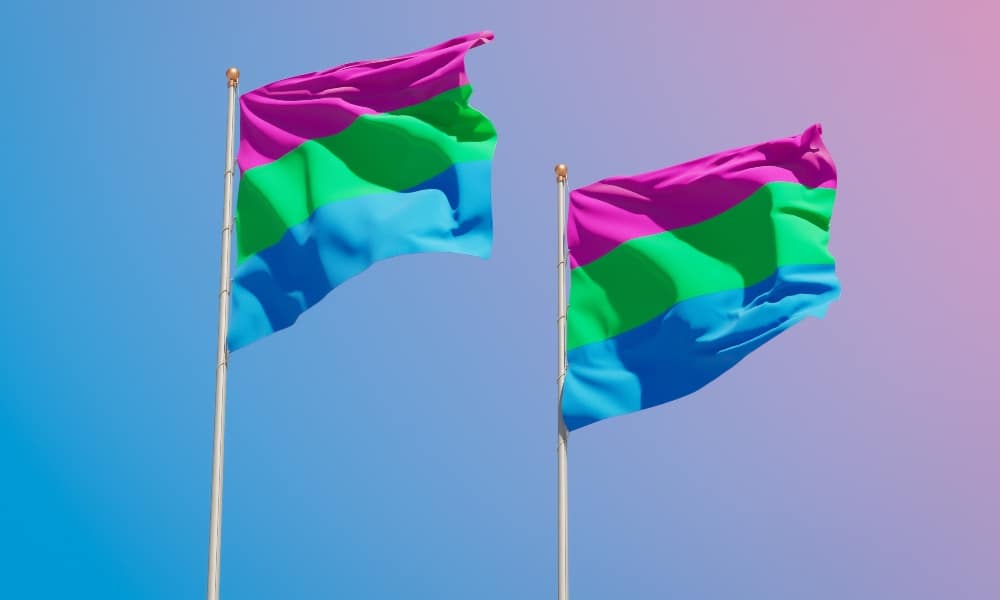Everything you need to know about the Polysexual Pride Flag.
Most people identify as monosexual, which means they feel attracted to just one gender (i.e., heterosexual or homosexual). However, plenty experience attraction to multiple (and, in some cases, all) genders. Many refer to this as polysexuality.
Much like the rest of the LGBTQ community, polysexuals have a unique flag to represent their sexual orientation. Keep reading to dive deeper into the polysexual pride flag, its history, and its meaning.
Related | Study Shows Sexual Boundaries Evolving
What Is Polysexuality?
Polysexuality is a sexual orientation that describes people who feel attracted to more than one gender. The prefix “poly” comes from the Ancient Greek word for “many.” This is in contrast to monosexuality, which is the attraction to just one gender.
Since multi-sexual attraction is not fixed and may vary from person to person, polysexuality can be difficult to define or categorize. As Cameron Glover, a business coach and sex educator, told Cosmopolitan: “Usually, when we talk about sexuality, it’s very much rooted in binaries — so, man/woman or nonbinary folks … But I think there is a conversation that can be had looking at sexuality beyond that.”
Polysexuality vs Pansexuality
The prefix “poly” means many but not necessarily all. Meanwhile, pansexuality is just one subcategory of polysexuality where the person is attracted to people regardless of gender.
For pansexuals, gender does not affect their attraction — they are attracted to the person, not what they identify as. In contrast, a polysexual person may consider gender when it comes to sexual attraction, sometimes preferring certain genders over others.
Polysexuality vs. Bisexuality
Bisexuality is defined as an attraction to two or more genders. According to the Bisexual Resource Center, bisexuality is a part of the polysexual umbrella. This means that while some polysexual people may identify as bisexual, not all do.
The History Of The Polysexual Flag
Tumblr user Samlin, who identified as polysexual, created the polysexual pride flag. They first submitted the design on July 11, 2012, to the account fuckyeahpolysexuality.

Leonid Altman / Shutterstock
Polysexual Flag Colors And Meaning
The most commonly used polysexual pride flag has three horizontal stripes in pink, green, and blue. The pink stripe represents women and female-identifying individuals. The green stripe stands for genderfluid and non-binary individuals, while the blue stripe is for men and male-identifying individuals.
In the original Tumblr post, Samlin explains their rationale for the flag’s color story:
“I, as a poly individual, was greatly saddened by the fact that we don’t have a flag…so I made one 😛 I made it similar to the bi and pan flags since they’re all under the multisexual umbrella.”
The Seven-Striped Version Of The Polysexual Flag
There is an alternative version of the polysexual flag with a meaning similar to the original Samlin design but with seven stripes instead of three. The additional stripes are light pink and blue, with white stripes sandwiching the light green stripe in the center. The white and light green stripes represent transgender and polysexual people.
People who identify as polyromantic often use this version of the polysexual pride flag.
Myths About Polysexuality
Polysexual people currently face many unfair stereotypes and assumptions about their sexual identity. According to Amney Harper, Ph.D., professor at the Department of Professional Counseling at the University of Wisconsin-Oshkosh, there are three main misconceptions about polysexual people:
- Polysexual people are promiscuous: While polysexuals are attracted to many genders, they may not necessarily act on that attraction at every opportunity. Sexual activity and drive are not related to sexual orientation.
- Polysexual people are attracted to everyone: In the same way that heterosexuals aren’t attracted to every one of the opposite gender, polysexuals are not attracted to everyone in the world. Types, tastes, and other preferences still come into play.
- Polysexual people don’t know what they really want: Some people may identify as polysexual and later identify with a monosexual label. However, that doesn’t mean that polysexuals have to eventually “choose” who they are attracted to.

How You Can Be An Ally To Polysexual People
- Accept and validate their identity, even if you don’t understand it.
- Approach them with genuine curiosity and learn about their personal experiences.
- Listen to your polysexual-identifying friends or loved ones when they open up to you.
- Learn more about the polysexual identity and the challenges polysexual people face.
- Speak up when you see someone invalidating a polysexual person’s identity.
The Bottom Line
Polysexuality describes a growing number of people who experience sexual attraction to many but not all genders. The polysexual pride flag is a reminder that sexual attraction and orientation aren’t monolithic. While most of society identifies as monosexual, there are plenty who don’t – and that’s perfectly valid and normal.
Related | Omnisexual vs Pansexual: What Is The Difference?







